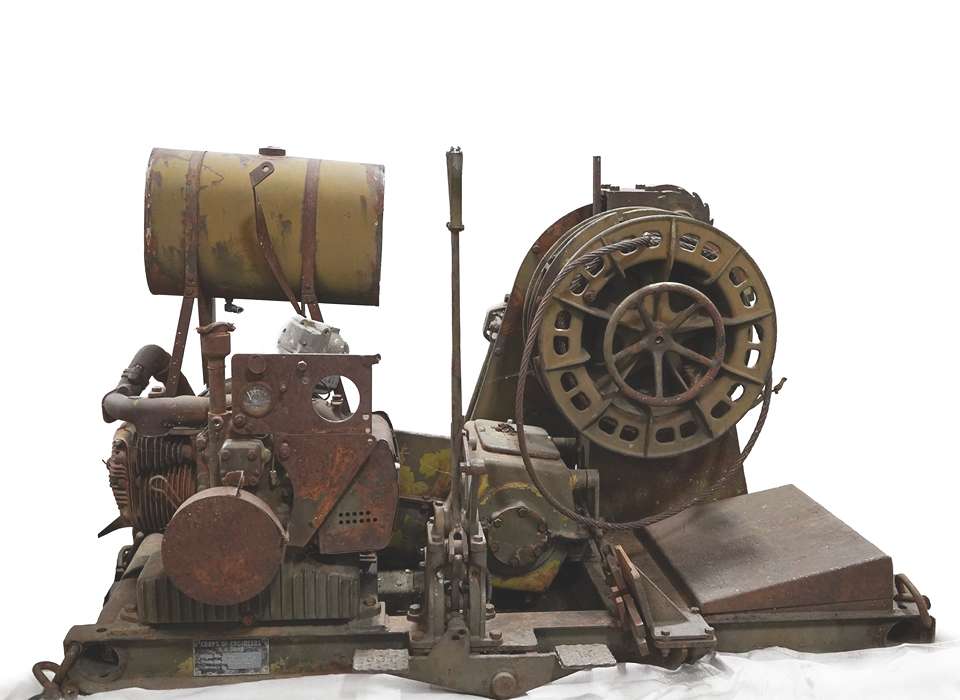On June 6, 1944 soldiers of the 320th Barrage Balloon Battalion (VLA) (Colored) landed on Omaha and Utah Beaches. They were the first African American unit to come ashore at Normandy, the first barrage balloon battalion to land in France, and one of the few units to land at both American beaches.
Barrage balloons were an effective anti-aircraft measure in World War I and were widely embraced in World War II. The idea was that the cables holding the balloons created a hazard for aircraft engaged in low-level strafing or bombing. By forcing enemy planes to fly higher, the effectiveness of their attacks was reduced. The United States Army planned to form over 30 barrage balloon battalions during the war. In keeping with the Army policy of segregation, four of the battalions were composed of African Americans soldiers with Caucasian officers. Initially the battalions were organized to have large hydrogen-filled balloons flying up to 15,000 feet. As the war progressed, the flying height and size of the balloons diminished, eventually evolving into the very low altitude balloon flying at 2,000 feet. Finally, as the need for barrage balloons diminished, many of the battalions were deactivated and the soldiers transferred to other types of units.
The 320th was formed at Camp Tyson, Tennessee on December 10, 1942. After almost a year of training, the battalion departed for Great Britain on November 17, 1943. Training continued at various sites in preparation for the Normandy invasion. Plans called for barrage balloons to be deployed as the first waves landed on the beach. This would provide immediate protection against close air attack. In order to place the desired number of balloons aloft, the crew size was reduced from 4 to 3 men per balloon. The standard very low altitude winch was also determined to be too heavy for an assault landing from a Higgins boat. Instead, a makeshift winch was constructed using parts originally intended to install communication wire.
For the D-Day invasion on June 6, 1944, soldiers from the 320th were scattered in landing craft up and down Utah and Omaha Beaches. Balloons were filled in England and towed across the channel by larger landing craft, then transferred to Higgins boats for the trip to the beach.
Barrage Balloons were successfully landed and flown on June 6. By June 21, there were 141 balloons providing protection to Omaha and Utah Beaches. After the port of Cherbourg was captured, the 320th provided Barrage Balloons at that location as well. By October 24, 1944, barrage balloons were no longer needed, and the battalion was withdrawn to England. On November 13, they sailed for the United States. During their service in France, three enlisted men were killed in action and one officer and sixteen enlisted men were wounded. It was planned that the 320th would be redeployed to the Pacific theater. After 30 days leave and more training, the unit arrived in Hawaii on May 6, 1945 where they remained for the rest of the war.
The 320th Barrage Balloon Battalion, Very Low Altitude (Colored) was a remarkable unit. The Museum is pleased to have recently acquired a winch of the type they trained with. The item is a M1 Very Low Altitude (VLA) Barrage Balloon Winch. Barrage balloons are stationary balloons that are tethered to the ground by a cable. The cable creates a hazard for aircraft and forces them to fly above the balloons. The exact height the balloon flies at is changed frequently. The VLA balloon had an upper limit of approximately 2,000 feet flying on a 1/8 inch cable. During planning, it was agreed that the VLA M1 Winch, weighing approximately 1,000 pounds, was too heavy to bring ashore in an assault landing, so a modified device was made from a Signal Corp winder for field telephone wire. These modified winches weighed about 50 pounds. They can be seen in photographs of the 320th at Normandy. They rely on human power to lower the balloons. Further research is needed, but Museum curators expect that the M1 winches were brought ashore at some point after the initial landing, as the 320th served for almost 150 days at Normandy.
M1 Very Low Altitude Barrage Balloon Winch
The Museum acquired this M1 winch after it was advertised online. After careful consideration, the Museum decided to add the piece to its collection. It was located in Hawkeye, Iowa, which complicated pick up. Following a method used many times before, the Museum flew a curator to Iowa where they rented a truck, drove to Hawkeye, loaded the winch, and then drove back to New Orleans.
The M1 VLA winch is powered by a Waukesha two cylinder gasoline engine Model 150-U; it has an assortment of chains and gears that allow the balloon to be lowered at fast or slow speed, and a brake to allow the balloon to ascend under its own lift. The winch is skid mounted. The Museum's winch is missing a few small parts including the carburetor. The cable on it is much heavier than the original. The winch is currently in storage awaiting restoration.
Tom Czekanski
Cite this article:
MLA Citation:
APA Citation:
Chicago Style Citation:




![Max Fuchs, New York City cantor, sings as Rabbi Sydney [sic] Lefkowitz, Richmond, VA, conducts the first Jewish services from Germany.](/sites/default/files/styles/max_650x650/public/2025-10/image1.jpg)





